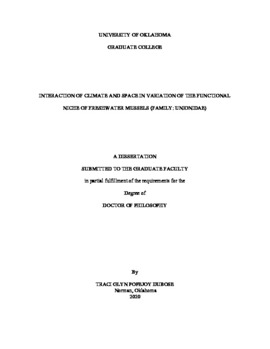| dc.description.abstract | Animals are an integral part of ecosystems: they consume and process materials, thus connecting the cycling of nutrients and matter through ecosystems. Freshwater mussels (order Unionoida) are a diverse group of bivalve mollusks that are highly imperiled. They reside on the bottom of rivers in discrete patches known as mussel beds and are aquatic ecosystem engineers that can have a strong impact on ecosystem function. Filter feeding mussels remove seston from the water and release nutrients (nitrogen and phosphorus) back to the riverbed and water through their egesta and excreta. These recycled nutrients fertilize and increase the abundance of algae, which are then eaten by stream animals such as insect larvae. Mussels also store nutrients in their soft body parts and shell, which are released when they die and can lead to algae blooms. Finally, mussel shells change near-bed hydrodynamics and provide habitat for other organisms. While all mussels perform these functions, different species exhibit considerable variation in their behavior, life history, and physiology, all of which describes their ‘functional niche’ or ecological role. This variation makes mussels ideal study organisms for investigating how species characteristics change through space and how this impacts ecosystem function. My dissertation contains three chapters: (1) variation in potential maximum size characteristics in freshwater mussels along a latitudinal gradient, (2) the impact of mussel ecosystem engineering on macroinvertebrates, and (3) how the effects of drought-driven mass mortality of mussels impacts ecosystem function. Collectively, my dissertation chapters examine how species’ characteristics allow them to cope with their changing environment.
My first chapter addresses mussel’s adherence to a general ecogeographic pattern, neo-Bergmann’s rule, that states larger animals are found in areas of lower temperatures (or higher latitudes). To examine this, I radially dissected shells from two mussel taxa that inhabit different thermal niches (Amblema plicata and Lampsilis spp.) to access annually deposited rings. From those annuli, I calculated von Bertalanffy growth parameters to describe the asymptotic maximum size of the mussels. As latitude is correlated with temperature, precipitation, and productivity gradients, I compared how different climatic gradients predicted this potential maximum length. I found that mussels grow larger at higher latitudes. Watershed precipitation and annual water temperature were negatively related to potential maximum size in both taxa. There is some evidence that thermal niche alters the size-latitude relationship. As climate change alters precipitation patterns and water temperatures, mussel taxa are likely to reach a smaller maximum size, which has implications for individual fecundity and thus population viability in the future.
For my second chapter, I used an integrative approach combining field experiments and a large field survey to investigate how the mechanisms and magnitude of ecosystem engineering by mussels changes with spatial scale. I used enclosures that contained assemblages of live mussels and “sham mussels”. I sampled macroinvertebrates at two levels in the enclosures: in the sediment of the enclosure (~0.25m2 scale) and the shell of the mussels (~10 cm2 scale). On a larger spatial scale and as a part of a larger investigation of consumer control of biogeochemical cycles, I sampled the macroinvertebrates at stream reaches with and without mussel beds (~1,000 m2 scale). I predicted that mussels’ alteration of near-bed velocity would be greatest at the ~0.25 m2 scale, while their control of food availability would be largest at the shell scale. I found that at larger scales (~1,000 m2), discharge and food availability drove macroinvertebrate community structure. At the shell scale (~10 cm2), live mussel presence predicted macroinvertebrate community structure the best, likely through bottom-up trophic effects. In rivers experiencing altered flow and nutrient regimes, ecosystem engineering effects of freshwater mussels are likely to diminish, causing ecosystem function loss.
Globally, droughts are becoming more frequent and intense, due to climate change and increasing human water withdrawal. As sedentary animals, mussels are sensitive to drought and because they are ecosystem engineers, their loss can have profound impacts on stream ecosystems. Several drought-driven mussel die-offs have been documented in the southern Great Plains, but we do not know the ecosystem impacts of these mortality events. For my third chapter, I conducted an experiment that simulated a mussel die-off and measured the resulting changes in ecosystem function. In three scenarios (control tanks, tanks with a live mussel community, and tanks with a mussel community that experienced a die-off), I measured water column nutrients, algae concentration, and organic matter decomposition before and after the mussel mortality event. After the die-off, nutrients increased in mortality tanks with nitrogen (ammonium) increasing by 94%. This rapid nutrient release stimulated algal production and subsequent decomposition in the mortality tanks. Based on this and previous studies, I developed a conceptual model that predicts that mass mortality of mussels likely reduces ecosystem function for many years through the loss of filtration capacity, nutrient recycling and storage, and habitat. This model should aid development of management strategies (such as water release from dams) that sustain river function in the face of drought.
Freshwater mussels make important contributions to ecosystem function, however the magnitude of this effect is likely to shift due to anthropogenic climate change leading to mussel declines and changing mussel habitat. Through their bio-filtration, habitat provisioning, and influence on nutrient cycling, mussels contribute to ecosystem services (ecosystem functions that are beneficial to and used by humans). Thus, as rivers dry and mussel populations dwindle, stream ecosystems will provide less ecosystem services, such as water provision and recreation, to human populations. By better understanding how mussels effect stream ecosystems and how important traits vary across space, water managers and conservation biologists can better conserve these threatened animals. | en_US |

